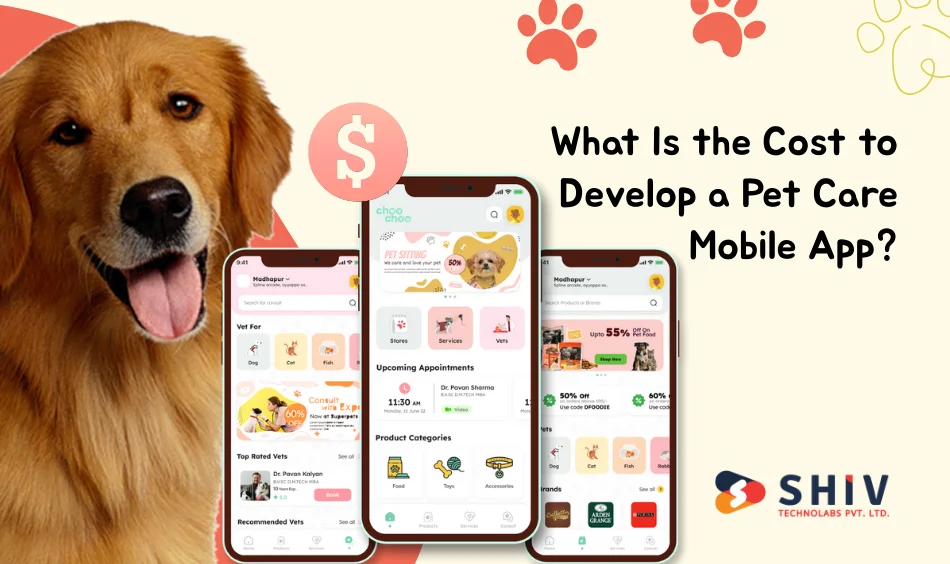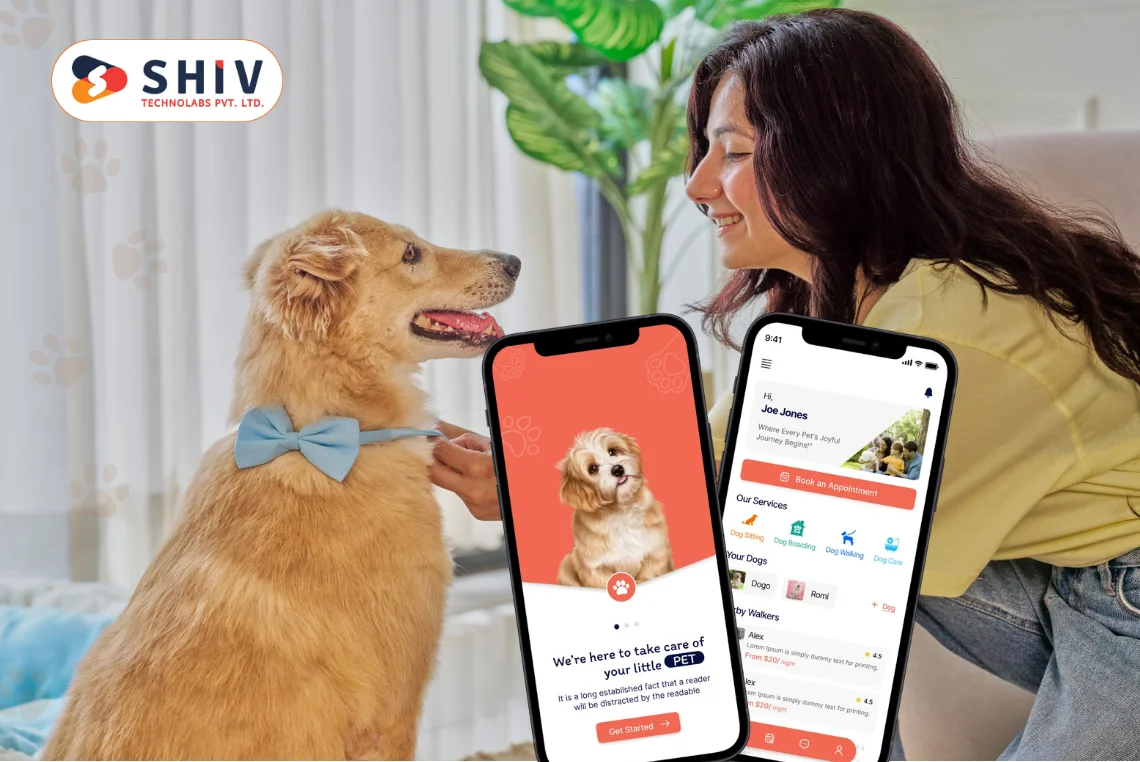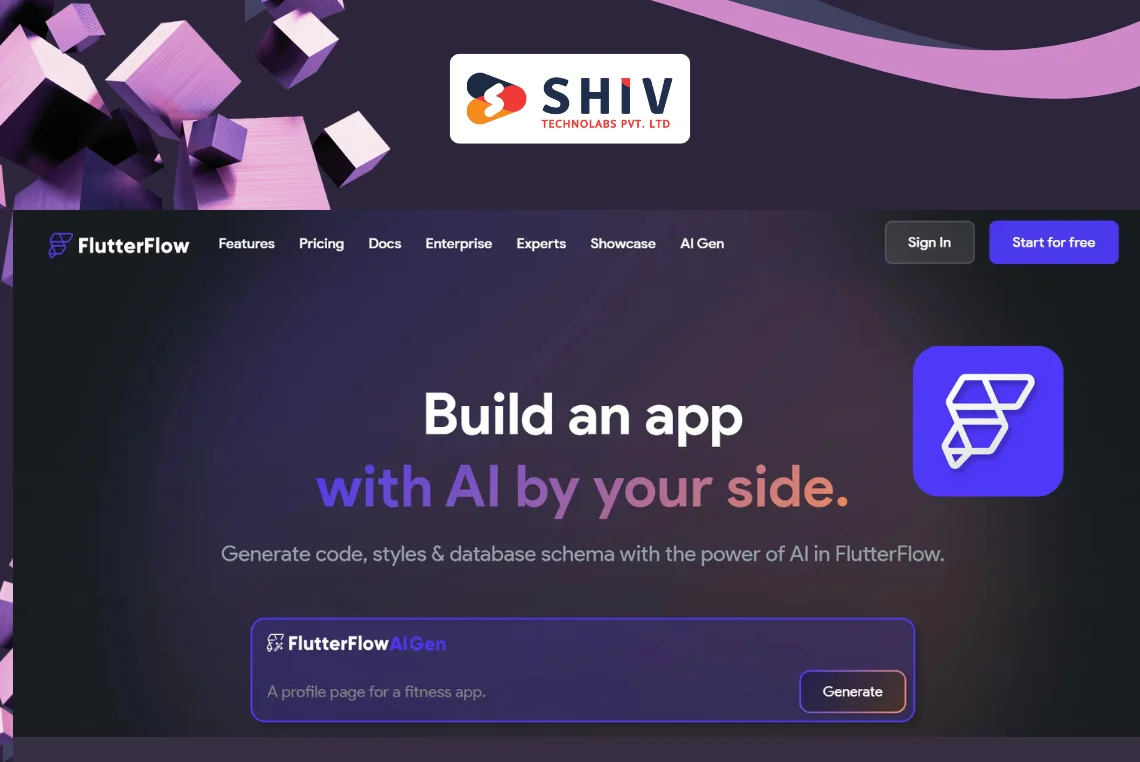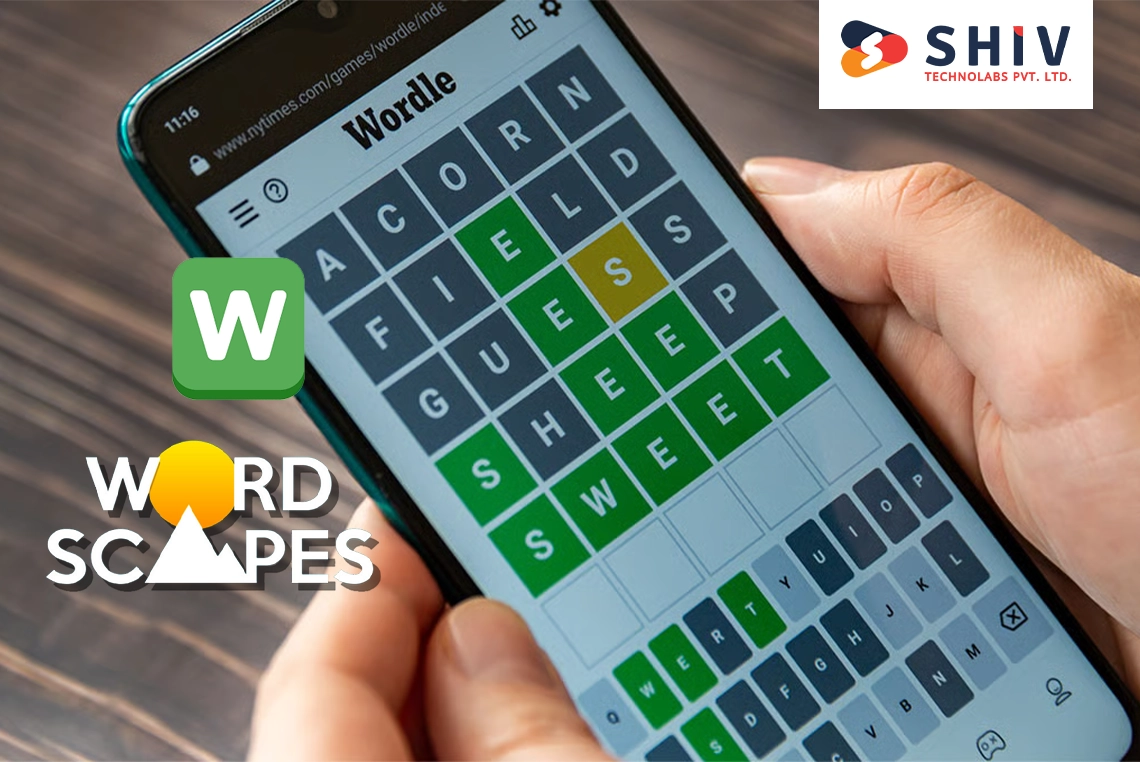Table of Contents
Look around, almost everything is operated via a mobile device. Pet care’s joined that crowd, too. Getting grooming done, buying food and supplements, those things happen with a few taps these days. Pet owners want instant access. This change pushed pet businesses to think differently. Selling stuff isn’t enough anymore; they’re creating digital systems that help owners stay on top of their pets’ needs.
According to reports, spending in the pet care industry is set to grow by 7% annually in 2030. Naturally, brands, groomers, and animal hospitals started working with mobile app development services to keep up.
Today’s pet care apps handle everything, setting appointments, tracking health stats, buying things, and earning points, all in one easy system. The businesses are better connected with customers and returning sales.
What Is Pet Care App Development and Why Does It Matter?
In simple terms, a pet care app is a mobile app designed to address various aspects of pet care: monitoring health, scheduling services, ordering pet supplies online, and enabling owners to communicate with service representatives, among others.
To be exact, this development links three groups: pet companies or shops, pet owners, and service providers (groomers, vets, boarding places, or walkers). When brands create a special application, serving pet owners becomes easier and opens the door to additional money-making opportunities.
Here’s what it does for businesses running pet product sales or offering grooming, daycare, or animal medical services:
- The benefits of pet care mobile apps for pet brands include more repeat purchases, as ordering and subscribing through apps is simple.
- Talking to pet owners right away works now: messages about health appointments, deals, service heads-ups.
- Setting bookings and handling orders gets easier; owners schedule grooming or visits to the veterinarian, pay up, and get updates right on their mobile device.
- Creating brand fans through points and a steady app experience gets simpler, helping brands pop out in a busy market.
If your business deals with pet stuff or services, a pet care app goes beyond being “nice to have”—it sets you apart in 2026.
How Does the Pet Care App Development Process Work?

Planning to bring in a development crew (say, working with a custom mobile app development company)? Here’s the usual path things take.
Step 1 – Market Research and Competitor Study
Before touching any code, find what’s missing in the market and check what others are doing. Which services aren’t well covered right now? What problems do pet owners mention in app reviews? What features do your close competitors miss? This drilling helps you figure out what makes you special and stops you from building features that don’t work.
Step 2 – Define Features and User Flow
After learning what the market needs, write down user stories for everyone using your app: the pet owner, the service person (groomer, vet, walker), and the brand or shop. Like: “As a pet owner, I need to book a grooming time for my dog, pay through the app, get a yes, and see a reminder pop up.” You’ll sketch screens, paths, and feature lists. Getting this clear now saves money on changes later.
Step 3 – UI/UX Design for Pet Apps
During pet care app development, the design part matters big time. An interface that makes sense keeps people using and coming back. Owners need to feel good as they move through the app, book services, buy products, and view pet info. Service people need easy ways to handle bookings, stock or service updates. Brands need control boards for rewards, deals, and numbers. Simple design, friendly pictures, pet-focused images—all this helps.
Step 4 – Development and Integration
Now comes building the tech side: backend work (servers, storage, APIs), frontend (iOS, Android, or work-anywhere), and connecting to external services (payment systems, text/alert providers, location/GPS for pet walkers or deliveries). Connecting live databases (like, for instance, updates of a pet walk, or following a pet food delivery) creates smooth experiences. You’ll add tracking modules too, so you can watch how people use it and make it better.
Step 5 – Testing, Launch and Support
Testing covers QA (problems, design edge cases), testing with actual pet owners and service people, and checking performance (especially if GPS tracking or live video matters). When it’s ready, you submit it to app stores. But going live isn’t the finish: keeping updates coming, fixing security holes, and making changes based on user feedback help you stay ahead and keep the app working well and safely.
Here’s a quick table overview of the stages:
| Stage | Tasks Involved | Time (Approx.) | Outcome |
|---|---|---|---|
| Research | Market study, competitor analysis | 1–2 weeks | Defined goals |
| Design | UI/UX wireframes | 2–3 weeks | User-friendly screens |
| Development | Backend & feature coding | 4–8 weeks | Functional prototype |
| Testing | QA and user feedback | 1–2 weeks | Error-free app |
| Deployment | Store submission & support | Continuous | Live app |
What Are the Key Features of Pet Care Mobile Apps?
Let’s dive into the main feature list. These are the key features of pet care mobile apps that brands need to think about.
User Profiles: For storing pet health and service history
Let pet owners set up profiles for each pet they have (name, type, age, medical past, shot records, grooming past). This lets service people see what they need before doing work, and brands make special offers based on pet-type or age.
Online Booking: Grooming, vet visits or pet walking
Let owners schedule services—grooming, vet checks, walking, daycare, right in the app. Booking times, paying, getting yes, alerts and updates all in the same place makes things convenient and builds loyalty. Clinics and hospitals can pair this with healthcare app development workflows.
E-Commerce Store: To build a pet care app for your pet store
If you sell food, gear, subscription boxes or health supplements, add an online store. Owners can look around, buy and set delivery times. The introduction of subscription services (weekly food deliveries, monthly treatment packages) creates a consistent source of income.
Health Tracker: Monitor vaccination, diet, and activity
Allow owners to be guided by noteworthy health details: weight modifications, shots, diet, and activity/walking data. For brands, it can be used to issue reminders or propose upgrades (e.g., better food, grooming) at the appropriate time. If you plan smart features, see our AI development services.
Push Notifications: Send reminders and offers
Send reminders about coming appointments, shot due dates, special deals or loyalty points. This keeps pet owners involved and makes them use it again.
In-App Chat: Easy communication with service providers
Add a chat or messaging option, which lets owners chat with groomers, vets, or shop staff directly in the app. This makes service clearer and creates trust.
GPS Tracking: Real-time updates for pet-walking or deliveries
If you do pet walking services or food delivery, GPS tracking adds openness. Owners see when their dog walker shows up, how long they walked, or follow the delivery live. This creates confidence in what you offer.
Reviews & Ratings: Build trust and transparency
Let owners rate services and products, and write about their experience. This input helps other users pick wisely, and it helps you watch the service person quality and product happiness.
Here’s a quick table summarising feature vs benefit:
| Feature | Benefit |
|---|---|
| Loyalty Rewards | Higher retention |
| Order Tracking | Transparency |
| Push Notifications | Better engagement |
What Is the Cost to Develop a Pet Care Mobile App?

When determining the cost to create a pet care mobile app, you will notice it is largely dependent on factors such as the design complexity, the type of application (basic or advanced), and the number of features you include.
Basic Pet Care App
A basic version might have user profiles, online booking and push alerts. Like: an owner books a groomer, gets a reminder, and pays through the app. Cost would usually land in the USD $8,000-$15,000 range.
Mid-Level App
A mid-level app could include online shopping (selling food/gear), GPS tracking (walkers or deliveries), in-app chat, and potentially loyalty points. These features make things more complex and pricey, so you might see USD $15,000-$30,000.
Advanced App
For a fully loaded app with smart health reading (tracking activity, suggesting diet/grooming), connections with wearables (for pet trackers), maybe AR for pet care learning, high growth ability—cost could hit USD $30,000-$50,000+. If you’re weighing cross-platform vs native, our Flutter services and Android development pages cover options.
Here’s the table to outline the estimated breakdown:
| App Type | Features Included | Estimated Cost (USD) |
|---|---|---|
| Basic Pet Care App | Booking, profiles, push alerts | $8,000–$15,000 |
| Mid-Level App | E-commerce, GPS, chat | $15,000–$30,000 |
| Advanced App | AI insights, wearables integration | $30,000–$50,000+ |
What Are the Benefits of Pet Care Mobile Apps for Pet Brands?
Looking at the benefits of pet care mobile apps for pet brands, the good parts are real and you can measure them. If your brand puts money into an app smartly, you can:
- Create straight connections with pet owners instead of counting only on retail shops or other platforms
- Gather insights on buying habits (what food a pet owner gets, how often they book grooming, which types show up most)
- Give personal deals and reminders (like sending a discount on a groomer visit when the dog hits 1-year-old)
- Make repeat sales and keeping customers better by holding owners’ attention through loyalty systems, push alerts and subscription options
Having your own app gives you your own way to communicate, collect info, and sell in ways that websites alone can’t touch.
How to Choose the Right Partner for Pet Care App Development
Picking the right pet care app development company can decide if your project works or fails. This goes beyond hiring coders—it means finding a strategic partner who gets your business targets, the pet industry, and how technology can make your idea real efficiently. Let’s explain what you need to look for when picking the right development partner.
1. Look for Domain Expertise in Pet Care and E-Commerce
Begin by checking whether the company has past experience in pet care mobile app development or similar service-based and online shopping projects. While any good developer can create an app, teams that understand the details of pet care, such as appointment scheduling, health monitoring, user profiles, or loyalty systems, can deliver faster and with fewer changes.
Ask for:
- Case studies of pet care, wellness, or service-booking apps
- Understanding of pet owner behavior and UX flow
- Experience connecting APIs for payments, GPS, and chat systems
Shiv Technolabs, for example, has worked with many niche industries and knows how to build scalable, customer-focused applications tailored to specific audiences. For full retail builds, see eCommerce app development.
2. Look at Technical Skills and Technology Stack
A professional custom mobile app development company should know both native (iOS, Android) and work-everywhere frameworks (Flutter, React Native). They should also suggest the right backend stack—Node.js, Laravel, or .NET—based on your growth targets.
Here’s what you should check:
- Experience in connecting live features (GPS tracking, chat, alerts)
- Knowledge of cloud solutions like AWS, Google Cloud, or Azure
- Ability to handle secure storage for keeping pet health info
- Knowing about wearable connections for advanced health monitoring
A tech-smart partner makes sure your app is not just working but ready for tomorrow.
3. Prioritize UI/UX Excellence
The pet industry runs on emotions and involvement. A good-looking, easy app can create stronger customer loyalty. When evaluating a development partner, check their UI/UX design process—do they create user personas, wireframes, and working prototypes before coding?
Your perfect partner should:
- Focus on mobile-first design ideas
- Customize visual themes to match your brand’s personality
- Make sure pet owners can easily move between booking, shopping, and monitoring
- Use friendly imagery, icons, and color schemes that connect with pet lovers
At Shiv Technolabs, our designers prefer compassion-driven interfaces, where all interactions between the user are natural and engaging.
4. Transparency in Pricing and Communication
One of the most missed but important parts is communication. You should feel good asking questions, getting regular updates, and understanding the cost setup. The cost to develop a pet care mobile app can vary significantly, so your partner must be upfront about timelines, milestones, and any additional costs.
Look for these signs of openness:
- Detailed proposals with feature-wise costing
- Weekly or biweekly progress reports
- Project management via tools like Jira, Trello, or Asana
- A dedicated point of contact for all updates
Open communication reduces delays and keeps your vision aligned with the final product.
5. Check Post-Launch Support and Maintenance
App development doesn’t stop at launch. Actually, that’s when real feedback starts. Pick a pet care app development company that gives ongoing maintenance, updates, and performance monitoring.
Solid partners provide:
- Regular bug fixes and performance improvements
- Adding new features based on user feedback
- Security patches to protect user info
- Growth solutions as your app gets more popular
At Shiv Technolabs, we don’t just create apps—we support you through every phase, ensuring your app evolves with market needs and continues to perform well.
6. Evaluate Client Reviews and Portfolio
Past performance tells a lot about a company. Review client testimonials, reviews, and portfolios. Some websites, such as Clutch, GoodFirms, or Google Business, tend to provide verified client reviews that can reveal how an organization copes with communication, deadlines, and after-sales services.
Look for patterns:
- Are clients from different industries?
- Do they mention responsiveness and technical problem-solving?
- Does the portfolio have feature-rich apps similar to your idea?
These are indicators of reliability and professionalism —qualities you will want in your long-term tech partner.
Conclusion
Developing a specific pet-care application offers an opportunity to raise your brand, engage pet owners more effectively, and tap into new revenue streams. The possibilities are enormous, ranging from simple booking applications to complex systems with artificial intelligence and wearable integration.
At Shiv Technolabs, we focus on crafting customized mobile applications, from concept to launch and beyond.
You may be a pet-food retailer, grooming service, or veterinary clinic; our end-to-end mobile application development solutions will help you make your vision a reality, satisfy pet-owner needs, and achieve growth.
Ready to get started? Reach out now, and let’s create your pet care app together.
FAQs
Q1. How long does it take to develop a pet care app?
The development process normally takes 8 to 14 weeks, depending on the app’s features, including e-commerce and GPS watch or wearable connectivity.
Q2. What is the average cost to develop a pet care mobile app?
Cost depends on features and complexity; it generally ranges from USD $8,000 for a basic app to USD $50,000+ for a fully featured offering with AI or wearable connection.
Q3. Which features make a pet care app successful?
Successful apps offer easy booking, pet health tracking, loyalty rewards, push notifications for engagement, and a secure checkout process for selling products or services.
Q4. Do pet care apps support online sales for pet stores?
Yes. You can add an e-commerce module to your app that lets pet stores sell food, accessories, and subscription boxes directly to owners, with a smooth ordering and delivery experience.
Q5. How can I hire the right pet care app development company?
Look for a partner with proven experience in mobile commerce, service-booking workflows, and preferably pet-care solutions. Review portfolios, check testimonials, and clarify cost setup and maintenance terms.






















